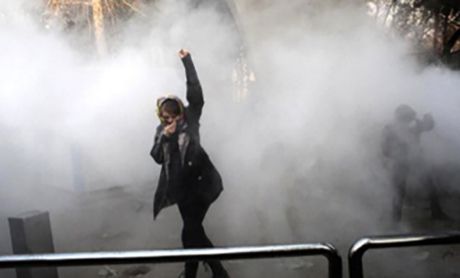Features
You are here
Resistance returns to Iran

February 28, 2018
In the last days of 2017, the western media showed pictures of protests in Iran. Hundreds took to the streets of Iran’s second largest city of Mashhad protesting high prices and shouting slogans against the government.
Western influence?
Everyone was wondering, who these protesters were and what their demands were, was it a genuine uprising or was it orchestrated by western powers, in particular the US and its allies in the region. These questions were totally justified, as only a few days earlier an Israeli delegation met US senior officials in the White House to discuss an “Iran Strategy”.
As soon as the protests began,Seyed Mohammad Hosseini, a self-proclaimed leader of a US-based group called “Restart”, took credit for the protests. He asked his followers to vandalize and burn banks, mosques and government offices. Trump, Netanyahu and King Salman sent support messages to the Iranian people. Confusion reigned among exiled Iranians and opposition groups who thought that these protests must be another colored revolution influenced by the west. Meanwhile the son of the last monarch and his followers as well as the Mujahedin-e Khalq (MEK) organization, both groups backed by the US and its regional allies (Israel and Saudi), supported the protests.
Impact of Sanctions and Austerity
President Rouhani’s budget announcement for 2018 was probably the spark that lit the fire of the pent-up anger of impoverished workers and other layers of people. 40% of the Iranian population is below the poverty line.
Despite all the variety seen in the slogans, the main reasons for these protests have been the poor economic situation, unemployment, inadequate minimum wage, non-payment of salaries, inflation, rising prices for food and other necessities, corruption and inefficiency. Rouhani’s proposed reductions in gasoline subsidies, which would significantly raise the price of gas, could have been another trigger.
Sanctions have drastically reduced the availability of medical services and imported drugs particularly the much-needed medications for cancer treatments. Many people see the sanctions as the Iranian government’s fault because of its poor relationship with the west.
By 2017, the purchasing power of workers had fallen sharply, work safety and confidence in the future worsened. The autocracy of employers, both private and public, supported by the judiciary, security and law enforcement, became wider and more rigorous. Any worker who objected to inadequate working conditions faced security and police encounters. Despite the promises of job creation, the number of unemployed people reached 6 million, the absolute majority of whom did not receive unemployment benefits. Gender-based, religious, national, and ethnic discrimination is rampant in the workplace. The use of child and pensioner labour, with much lower wages than the approved minimum, as well as the unequal wages paid to women workers and the use of double oppression, add to the severity of the situation.
Recent Struggles
Aside from scattered violence and vandalism caused by “Restart” followers, these protests were in fact built on the demonstrations from previous months, i.e. the ongoing protests of teachers, bus drivers, factory workers, retirees and victims of bankrupt credit institutions. Women have been fighting with oppression and inequality for decades. Compared to the 2009 Green protests, the geographic scope of these demonstrations was greater, but the number of attending people was smaller.
Protests are not new in Iran. In 1992, there were large uprisings in Mashhad when President Rafsanjani turned towards a more neoliberal market and inflation rose to 40%. Under Ahmadinejad there were protests in 1995 in Islamshahr and Tehran against raising gas prices. In 2016, more than 1,300 strikes and labor protests were recorded that are unique in contemporary Iranian history. In the first quarter of 2017, about 5-6 labor demonstrations and strikes were held every day.
Two new protest groups have added to the street power of marginalized people: first, the protests of moneylenders robbed by non-regulated, bankrupt financial institutions; and the second was the movement that took place in small towns against the government's water and climate plans. Dam construction projects, the drying of rivers and wetlands, the destruction of underground water resources in the country, and the spreading sandstorm phenomenon in the cities caused by rural deforestation, have shown the potential for multiple uprisings in the cities. This is especially true since the government refuses to address these environmental issues, indeed is the cause of them.
Conclusion
The dilemma facing the Iranian people is that while they oppose the state’s power, they fear that their protests may be co-opted by the West, as seen with Trump’s and Netanyahu’s support of the protests. Similarly, the Iranian diaspora, in its efforts to show solidarity with the protests, fear co-optation by western governments and right-wing Conservatives.
Ultimately, it will be the organized Iranian working class, acting in its own interests that will bring about democracy and economic fairness in the country. All our efforts should go towards supporting their struggles, and standing up to western interference.
Section:










